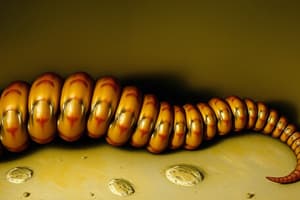Podcast
Questions and Answers
What is Phylum platyhelminthes?
What is Phylum platyhelminthes?
Dorsoventrally flattened, hermaphroditic, acoelomate, parasitic
What is the characteristic of Class Cestoda?
What is the characteristic of Class Cestoda?
No true gut, segmented, definitive host specialists
What is Taenia saginata known as?
What is Taenia saginata known as?
Beef tapeworm
What is the scolex?
What is the scolex?
What does the rostellum do?
What does the rostellum do?
What does the ventral sucker surround?
What does the ventral sucker surround?
Where is the genital pore located?
Where is the genital pore located?
What is a proglottid?
What is a proglottid?
What does strobila refer to?
What does strobila refer to?
What does acetabulum refer to?
What does acetabulum refer to?
What type of scolex do pseudophyllidia have?
What type of scolex do pseudophyllidia have?
What characterizes cyclophyllidia?
What characterizes cyclophyllidia?
What is Diphillobothrium latum primarily associated with?
What is Diphillobothrium latum primarily associated with?
What hosts does Moniezia expansa infect?
What hosts does Moniezia expansa infect?
What animal acts as the definitive host for Dipylidium caninum?
What animal acts as the definitive host for Dipylidium caninum?
What role do fleas play in the life cycle of Dipylidium caninum?
What role do fleas play in the life cycle of Dipylidium caninum?
What type of animal acts as the definitive host for Taenia pisiformis?
What type of animal acts as the definitive host for Taenia pisiformis?
What is a major characteristic of Taenia hydatigena?
What is a major characteristic of Taenia hydatigena?
What is the definitive host for Taenia solium?
What is the definitive host for Taenia solium?
What is Echinococcus granulosus known for?
What is Echinococcus granulosus known for?
Flashcards are hidden until you start studying
Study Notes
Phylum Platyhelminthes
- Characterized by dorsoventrally flattened bodies.
- Organisms are hermaphroditic, possessing both male and female reproductive structures.
- Acoelomate structure; lack a true body cavity.
- Mostly parasitic, adapted to host environments.
Class Cestoda
- No true digestive system; absence of mouth, gut, and anus.
- Body segmented into units called proglottids.
- Life cycle includes intermediate hosts (IH) that are usually prey and definitive hosts (DH) that are predators.
- Specialists in adaptation to definitive hosts.
Taenia saginatta
- Known as the beef tapeworm.
- Humans serve as definitive hosts, while cows are the intermediate hosts.
- Sometimes utilized in diets as a supplement.
Scolex
- The anterior end of the tapeworm characterized by attachment structures.
Rostellum
- A structure found on the scolex that holds hooks for attachment to the host.
Ventral Sucker
- A structure that surrounds the hooks and rostellum for secure attachment.
Genital Pore
- Located on the side of the tapeworm, facilitating reproduction.
Proglottid
- Individual segments of the tapeworm that may vary in size and width.
- Contains reproductive organs: E for ovary, A for pore, C for testes.
Strobila
- The entire body segment of a tapeworm excluding the scolex.
Acetabulum
- Term for the ventral suckers found on the scolex, used for attachment.
Bothrium
- A type of scolex characterized by two elongated shallow slit-like structures.
Pseudophyllidia
- Refers to the broad fish tapeworms.
- Scolex features two elongated bothria and produces large, operculated eggs.
- Diphillobothrium latum is the primary species studied.
Cyclophyllidia
- Characterized by scolex with four acetabula.
- Produces smaller, non-operculated eggs.
- Parasitizes primarily birds and mammals.
Diphillobothrium latum
- Definitive hosts include bears and humans; eggs shed in feces.
- Lifecycle involves copepods as the first intermediate host and fish as the second.
- Adult tapeworms can exceed 10 meters in length, residing in the small intestine.
Cyclophyllidean Larva Forms
- Larvae exhibit no asexual reproduction (e.g., cysticercoid, cysticercus, strobilosercus).
- Asexual forms include coenurus and hydatid.
Cysticercoids
- Larval forms found exclusively in arthropod intermediate hosts due to their small size.
Moniezia expansa
- Definitive hosts are ruminants, both domestic and wild.
- Soil mites function as intermediate hosts, developing cysticercoids after ingesting eggs.
Dipylidium caninum
- Definite hosts are wild and domestic canids that shed egg packets.
- Fleas and chewing lice serve as intermediate hosts, where eggs develop into cysticercoids.
Raillietina spp.
- Numerous species parasitize wild and domestic birds.
- Terminal gravid proglottids are released as egg packets.
- Fleas, ants, and chewing lice are intermediate hosts with larval development occurring within.
Taenia pisiformis
- Definitive hosts include wild and domestic canids.
- Intermediate hosts are rabbits, where cysticerci form after eggs are ingested.
Taenia hydatigena
- Similar to T. pisiformis; definitive hosts are wild and domestic canids.
- Ruminants serve as intermediate hosts, developing cysticerci after ingesting eggs.
Taenia solium
- Humans are the definitive hosts for this species.
- Pigs and bears act as intermediate hosts, with onchospheres leading to cysticerci in the intestine.
- Visible cysticerci appear in meat, resembling tapioca.
Echinococcus granulosus
- Known as the hydatid worm; definitive hosts are wild and domestic canids.
- Intermediate hosts can include various mammals, such as cattle and humans.
- Eggs hatch in the small intestine, migrating to the bloodstream and often ending up in the liver, where hydatid cysts develop.
- Each onchosphere that develops in intermediate hosts can produce numerous protoscolices through asexual reproduction.
Studying That Suits You
Use AI to generate personalized quizzes and flashcards to suit your learning preferences.



